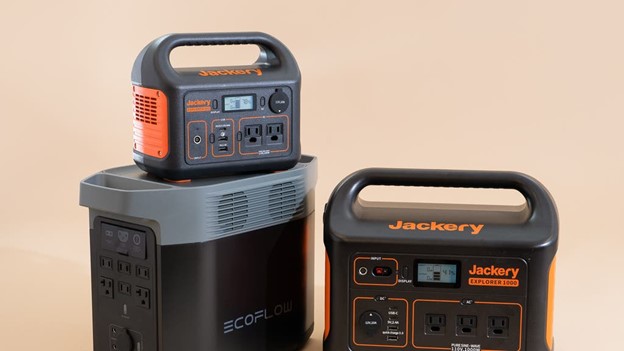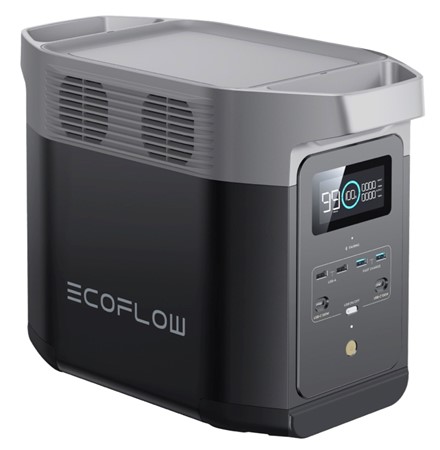
What is a Power Station, and Why Do I Need One?
Portable power stations combine a large-capacity battery with control systems and outlets to charge your phone or laptop, or run your appliances or refrigerator during power outages. Most models include a display to show the amount of power remaining, a battery management system to keep the battery from becoming over- or under-charged, and a phone app to let you tweak various settings.
Just like having a power bank to recharge your phone on the go, these larger versions come with larger batteries and more robust electronics, able to power larger appliances that require more energy to operate. This extra capability opens up a wide range of uses, from emergency home power backup, to powering devices that aren't near an outlet, to use while camping or in an RV. As an example, the EcoFlow Delta 2 portable power station can run a refrigerator for 8+ hours during a power outage, or recharge your phone about 90 times!
A typical use for a portable power station is during natural disasters or other situations where grid power is down. A high priority during such a time will be keeping food in a refrigerator or freezer cold so it doesn't spoil, keeping cell phones and laptops recharged, running lamps, or even a toaster or microwave to heat up food.
Unlike gasoline generators, portable power stations do not require storing gasoline in your home, do not require oil or regular engine maintenance, are much quieter, and do not emit any dangerous carbon monoxide or other emissions - and therefore can be kept and used in the home. While generators that are not regularly started up, run, oiled, and maintained are likely not to start up when you need them most, portable power stations are ready to go at the push of a button (though it is a good idea to recharge the batteries a bit every few months or so).
Specifications to Look For
The market for portable power stations has matured in the last few years. Many models are now in their 2nd or 3rd generations, with new features and conveniences, and prices have come down dramatically from when they were first introduced, making them cost-effective alternatives to generators.
A wide variety of sizes and capacities are available to meet different needs. Smaller models can weigh 5-10 pounds, mid-range models will weigh in around 20-30 pounds, and larger "pro" models with more capacity can be 50-100 pounds or more. In general, the larger models will have larger batteries that can power appliances for longer, and run more appliances at the same time.
There are two main specifications to look for in a power station. The first is the capacity of the battery, given in Watt-hours (Wh) or Kilowatt-hours (1 kWh = 1,000 Wh) for larger models. A larger battery with a higher capacity can power your devices or appliances longer before running out.

Our example system, the EcoFlow Delta 2 , boasts 1,024Wh capacity and 1,800W of AC output
A portable power station with a 1,000 Wh capacity can power an appliance that uses 100 Watts for 10 hours - or an appliance that uses 1,000 Watts for 1 hour. For an example of a typical use case, a refrigerator may use about 100 Watts per hour, and thus a power station like this may be able to keep your refrigerator running for 8-12 hours during a power outage. (Since refrigerators are well insulated if kept closed, you can probably extend this time significantly by not running it constantly.)
Aside from battery capacity, the other number to look at is the AC output. This is the maximum number of Watts the device can power at one time. A unit with a higher output (like 1,800W) can power larger appliances like refrigerators, toaster ovens, and microwaves. Or, it can power a number of smaller devices that use up to 1,800W together. (Most units also list a surge rating, 2,700W for example, which is helpful as some devices draw a lot of power for a short time when starting up. A refrigerator that draws 100W on average may spike up to 900W briefly when first plugged in.)
Other factors to consider include the number of outlets (including both AC outlets to plug in appliances, as well as USB-A or USB-C outlets to recharge phones or tablets), and the battery recharge speed, which will be discussed below.
Types of Batteries
There are two main types of batteries (or battery chemistry) you will find in portable power stations. The first is Lithium-ion, which is the type of battery used in phones, tablets, and many small electronic devices. Lithium-ion batteries have high capacity for their size and weight (making them ideal for phones where size and weight are very important), but can be dangerous if punctured, if they get too hot or cold, or if they are overcharged or undercharged.
Due to these limitations, most modern power stations use a safer battery chemistry known as Lithium Iron Phosphate, sometimes known by its chemical symbols of LiFePO4, or just LFP for short. While these batteries are a bit larger and heavier, they win out in two key areas: safety and longevity. First, they are much safer and less likely to cause a fire even if overcharged, undercharged, or subjected to extreme temperatures. Second, they last much longer (everyone knows their phone battery starts to lose capacity after about 2 years), can do many more charge/discharge cycles (often 5,000 or more before losing much capacity), and are more tolerant of being kept stored at 100% charge without losing capacity. Hence, your power station with an LFP battery should last for 10 years or more with close to full capacity.
Re-Charging Your Power Station & Adding Solar Power
While a typical use case is to keep your portable power station charged up and ready for an emergency, once you start using the battery it will need to be recharged. There are typically multiple ways to recharge power stations, with the most common being to simply plug it into a wall outlet. Here a key factor is how fast it will recharge. The Delta 2 can recharge at 1,200W, and boasts recharging from 0-80% in just 50 minutes or 0-100% in 80 minutes.
In cases where power is down or you are traveling, power stations can be recharged via a car lighter adapter, or via solar panels. Recharging via solar panels is especially attractive during a power outage, as it can indefinitely extend the amount of time you can keep your refrigerator and critical devices powered. (Most power stations allow you to recharge via solar and power devices at the same time.)
Learn more about recharging options and adding solar panels to your power station here.
Limitations
While portable power stations have come a long way and are incredibly useful devices, and have many advantages over gasoline generators, there are some limitations to be aware of. First, only the largest, heaviest, and most expensive models may be able to run central air conditioning units, which often draw about 4,000W of power, with an even higher surge. Even if they had the output to handle such a power draw at all, that would drain all but the largest of systems very quickly.
Second, if grid power goes down, it may not be easy to recharge your power station. As mentioned above, most models have alternate inputs (like via a car's lighter adapter or via solar panels), but recharging speeds may be limited, especially on cloudy days. In this respect, a gasoline generator may have advantages during long power outages (although perhaps your nice neighbor will let you use their generator to recharge your power station!).